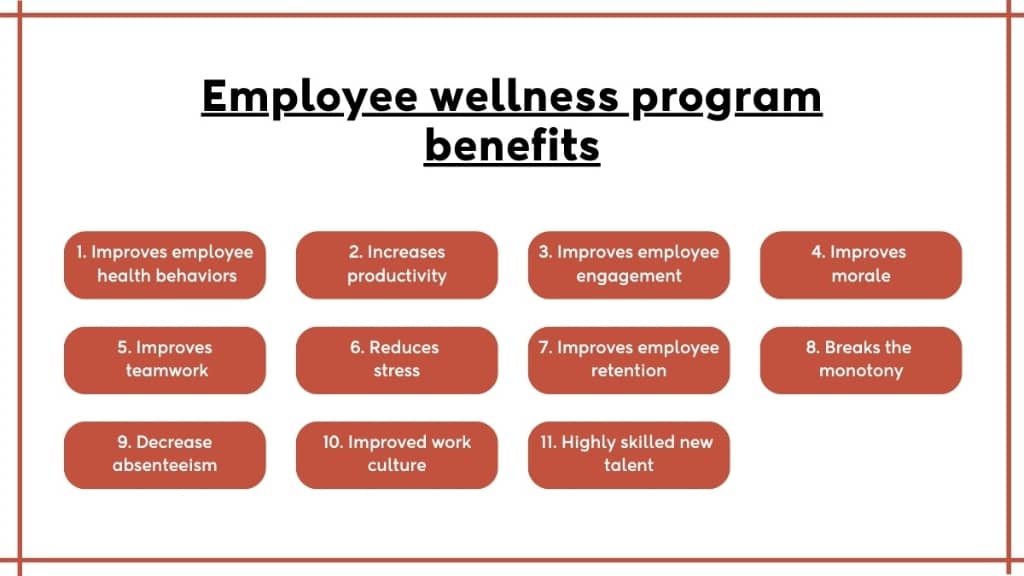According to a Gallup’s Report, “a staggering 44% of employees suffer from daily workplace stress“.
Do you want your team members to be part of this distressing percentage?
The mental and physical strain they endure can affect their productivity and health, ultimately impacting the organization.
As a manager or leader, you should recognize the importance of taking care of your employees.
A good employee wellness program can help you achieve this goal. It provides various options to boost your employees’ physical and mental health.
In this article, we will learn about employee wellness programs. How they work, what benefits they offer, and how to choose the right program for your organization.
What is an employee wellness program?
An employee wellness program is an initiative implemented by an organization to encourage and support the overall health and well-being of the employees and their extended families. This program is designed to improve physical fitness, mental health, and lifestyle habits among employees.
Common components of an employee wellness program include fitness challenges, nutrition education, stress management resources, preventive health screenings, and incentives to encourage healthier behaviors.
The goal of employee wellness programs is to enhance employee health, reduce absenteeism, improve productivity, and create a positive workplace culture.
Types of wellness programs
A business can offer various types of wellness programs. Depending on their specific needs and goals, workplace wellness initiatives can be set up as basic, optional, advanced activities, or prevention-focused programs.
1. Basic counteractive action programs
Basic prevention programs are a popular type of wellness program that encourage workers to engage in wellness practices that will enhance their overall health and well-being.
These programs often focus on managing stress, promoting healthy eating and exercise, and other practices that promote general wellness.
2. Secondary or optional programs
Secondary or optional programs are designed to reduce risky behaviors that are viewed as risky to a person’s wellness.
Some examples of such projects are programs aimed at the cessation of smoking and screenings for hypertension and other cardiovascular illnesses.
3. Advanced wellness programs
Advanced wellness programs target existing medical issues, which can result in a decrease or control of symptoms, or help moderate a disease’s progression.
Projects such as these may encourage workers to adhere strictly to explicit prescriptions or self-guided considerations, and can be particularly beneficial for those who are dealing with chronic conditions.
4. Prevention focused programs
Prevention-focused programs are another popular type of wellness program that companies can offer. These programs focus on prevention, with the goal of ensuring that the workforce is healthy and productive over the long term.
Although the profitability of investment in these programs is debated, many organizations sponsor these programs in hopes of improving well-being, resolve, and profitability over the long haul.
5. Employee wellness program examples
One of the best ways to make sure employees are in the best physical condition for their jobs is through employee wellness programs.
Employers can incorporate wellness in a variety of ways, and it is up to the organization to choose the most effective ones for their particular requirements.

- Yoga classes
Employees’ mental and physical health can be improved by incorporating yoga into their lives.
Yoga has numerous benefits, in addition to improving flexibility, strength, balance and concentration. Furthermore, yoga poses can reduce physical pain and workplace stress.
Yoga has the advantage of being more affordable than other workplace wellness programs.
As long as you have a few mats and some willing participants, yoga doesn’t take up too much time. As our workday has shifted, we need to find ways of staying active.
One way you can do this is with short exercises and stretches in your office. With so many healthy options available, there’s no excuse not to take care of yourself.
- Assistance programs
In addition to catering to employees’ physical needs, wellness programs should also address their mental needs. Personal support for problems like substance abuse, stress, anxiety, and depression can be given by employers.
Employers can provide guided support programs to employees to help them cope with many work-related stress issues.
Programs like these help employees perform at their best by bringing them peace of mind. Employers and employees benefit from them because they boost confidence and satisfaction.
Read more- How to deal with work stress and anxiety
- Naps
A power nap after lunch on a busy day always makes you feel refreshed. This is why businesses like Asana, Google, and Facebook typically have designated nap rooms where employees can go for a quick nap after lunch.
Naps can refuel workers so they can return to their work with renewed energy. Naps have been shown to increase productivity in clinical studies.
- Create challenges
It is important to make wellness activities fun in order to attract the attention of employees. The participant will also be more likely to change their behavior if they participate in social activities that are competitive.
For example, you can motivate employees to participate in a 30-day weight loss challenge or a 15,000-step per-day challenge, then present a prize to the victor.
Encourage healthy lifestyle changes by awarding points for nutrition, physical activity, and lifestyle changes.
- Onsite fitness accommodations
Despite the fact that the focus is now on the overall well-being of your team, you can still offer specific fitness programs.
In the past, companies often subsidized memberships to local health clubs and encouraged their employees to exercise outside of working hours to promote employee wellness.
Generally, people who would have taken advantage of this type of program already have gym memberships, so it’s only nominally successful.
You should rather spend money on an on-site fitness facility and encourage your employees to work-out by letting them have a one-hour break during working hours.
This way your employees will have a chance to work with friends and coworkers and also they don’t have to travel too far before work or after work.
- Offer flexible working hours
There can be some employees in your office who prefer to work in the night and while others do their best in the morning.
If taking a long lunch break and going for a run will improve someone’s productivity, then you should allow it. Offering flexible working hours can be a great way of helping your employees maintain work-life balance and as a result, perform better at work.
Allowing your team to plan their own schedules and structure their days in a way that suits them demonstrates your trust in them.
- Healthy lunch and snacks
Employees usually have very little time to consume their meals, which is why they often opt for fast food. Businesses can support their team members by providing them with enough time during lunch breaks to engage in healthy activities like going to the gym, playing sports, or having a nutritious homemade meal at home.
Some businesses, such as Google, have cafeterias where their staff can socialize and enjoy catered snacks and lunches throughout the workday.
Additionally, there are now healthy snack delivery services available, which eliminate the need for workers to go out and find food. These services deliver healthy snacks and meals directly to the workplace.
Having effective and healthy snack and lunch programs at work promotes healthy eating habits among employees, which is beneficial for both their physical and mental well-being.
- Community service activities
Many people typically feel really good and satisfied when they perform charitable work and assist others. Companies can encourage this by planning a day for employees to participate in community service.
Employees can create organizations and fundraisers to support charities they are passionate about. These initiatives also support the development of stronger bonds between employees.
- Mental health assistance
A mental wellness program assists workers who may be dealing with tough times, such as depression, anxiety, or related issues. This program provides expert guidance and advice in a private setting, away from the workplace.
It offers support for both personal and work-related problems, allowing staff members to function effectively with the help of expertly run assistance sessions.
In addition, this program demonstrates a greater level of compassion from managers towards their team members, which can help boost employee optimism and job satisfaction within the organization.
- Mindfulness meditation
Among people suffering from serious illnesses, mindfulness meditation can reduce symptoms of stress by 30%.

According to a Stanford University study, practicing mindfulness meditation can also lead to a greater sense of control over one’s life.
Given the numerous medical conditions linked to stress, such as anxiety, depression, and heart disease, incorporating mindfulness meditation into daily activities can be beneficial for employees.
Mindfulness meditation programs are becoming increasingly popular in workplaces and can involve various activities, such as breathing exercises, cultivating optimistic thoughts and feelings, and meditation.
Allowing employees to take a 10-15 minute break between work to do mindfulness meditation can help improve their overall well-being and performance at work.
- Wellness adventures
Many companies offer fitness subsidies, health benefits, and reimbursements for wellness programs. Fitness coordinators at the company say physical activity should be encouraged, but not mandated.
The ProofHub follows a unique approach to wellness efforts by organizing monthly events and sports activities every weekend for interested employees. Cricket, cycling or bedminton could be examples of one-hour experiences that employees can enjoy.
Organizing wellness outings is a wonderful experience for everybody. Keep in mind that not everyone can partake in all physically demanding activities.
By planning a variety of monthly activities, you can encourage people who don’t exercise much. More people find it appealing because it prioritizes enjoyment over physical activity.
Employee wellness program benefits
According to one study, 61% of employees agree that their employer’s wellness program has helped them make better lifestyle decisions.
Businesses should support and promote employee wellness for a variety of benefits. Here are some of the most prominent benefits you should consider.

1. Improves employee health behaviors
According to research, wellness initiatives can motivate workers to quit smoking, eat healthier, exercise more, and handle stress better.
Any wellness program’s primary objective is to change and enhance employee behaviors. By doing so, you can help your colleagues reduce their health risks and adopt a healthier lifestyle, which will have a positive impact on all aspects of their lives.
Wellness programs can help manage and reduce symptoms of depression, contributing to employees’ overall well-being.
2. Increases productivity
Employees who maintain healthier lifestyles tend to feel more productive at work, as they are more relaxed, energized, and motivated to complete their tasks.
If your employees are taking part in the wellness programs at your workplace, they are able to concentrate on keeping their healthy lifestyle, which has helped employees in better sleep, staying more productive at work.
3. Improves employee engagement
Businesses that prioritize employee wellness programs tend to attract more dedicated employees. When workers participate in activities such as weight loss challenges and other wellbeing initiatives, they tend to feel more connected to their employers and colleagues.
This can increase the likelihood of employees staying with the company for an extended period by creating stronger bonds between coworkers and managers.
4. Improves morale
Employee wellness programs boost employee morale, as participating in these programs generates a sense of satisfaction among employees.
When employees take part in wellness programs, they experience greater support from their employers in achieving their personal wellness objectives. This helps employees feel that they are being valued fairly by their managers.
In addition to boosting morale, wellness programs also add diversity to the workday. By offering educational initiatives and wellness programs, employers can expose their staff to new ideas and activities that are both fun and beneficial.
Such programs can help encourage staff engagement and raise morale, leading to a more productive and happier workplace.
5. Improves teamwork
The quality of employees’ work improves when they work well in teams. Teamwork also leads to better collaboration and more innovative ideas, which makes employees more creative.
Employees can strengthen their relationships with one another through participation in wellness programs, especially team-based activities, by encouraging and holding one another accountable.
Participating in wellness activities outside of the workplace can also improve communication and collaboration in the workplace by creating a sense of team bonding and camaraderie.
6. Reduces stress
In our day-to-day lives, we all face workplace stress. Employees and employers alike are adversely affected by stress. In addition, it reduces employee productivity and causes them to take unnecessary sick days because of poor health.
In order to improve employees’ productivity and performance, you can offer wellness programs to reduce workplace stress.
Furthermore, this can result in a lower employee turnover rate and a better health status for employees. As a result, employers’ health care costs are also reduced. Stress can be relieved and relaxation can be achieved through activities such as exercise and meditation.
7. Improves employee retention
Employee retention is strongly influenced by wellness programs. By providing an effective wellness program, employers can keep their employees loyal and satisfied.
A wellness program helps employees achieve their personal goals, which can make them more dedicated to their employer.
Offering a wellness program is a way for employers to demonstrate that they care about their employees’ health and wellbeing. It shows the company’s commitment to supporting its employees and emphasizes their importance to the organization.
When employees feel respected and valued, they are more likely to stay with the company and not look for other opportunities.
Want to prevent quite quitting in your workplace? Learn 13 practical ways in this comprehensive guide
8. Breaks the monotony
It is boring, repetitive, and exhausting to do the same thing every day. The morale and productivity of employees are affected by this.
Your employees will feel motivated and engaged when they take part in wellness programs. It’s fun and beneficial to learn and do new things that promote health and fitness.
As a result of wellness programs, employees become more enthusiastic about their jobs and work environments become more positive.
9. Employee wellness programs decrease absenteeism
According to the CDC, absenteeism costs the US economy over $225 billion, or over $1,685 per employee.
Wellness programs can help decrease absenteeism, thereby reducing these costs. The health of employees can be improved in a number of ways, which will help in reducing absenteeism.
Incorporating the employee wellness programs in organization can:
- Help boost the physical and mental health of employees
- Provide tools to employees for stress management
- Support staff in lowering and maintaining healthy blood pressure, cholesterol, and glucose levels
- Encourage individuals to maintain a healthy weight
In addition to enhancing employee health, these great developments also reduce absenteeism, which lowers costs for the employer.
10. Improved work culture
Employee wellness programs are beneficial for achieving high engagement and productivity among employees, which leads to a positive work culture.
These programs can create a warm environment and strengthen connections between employees, both of which are necessary for driving an organization towards success.
11. Highly skilled new talent
Employees who possess advanced skills and talents are less likely to settle for just any workplace. Apart from salaries, they prefer working for business owners who respect them and provide appropriate benefits.
Businesses that put in the effort to give their employees the tools and resources to maintain their wellness always have a significant advantage.
A wellness program is seen as a huge plus by potential employees as it demonstrates the company’s commitment to developing a positive workplace environment.
Conclusion
To put it briefly, improving employee wellness is crucial for any company, regardless of its size. One way to achieve this is by implementing employee well-being initiatives. You can research what similar companies are offering to get an idea of what you want.
Employee happiness and well-being can benefit both you and your staff. Employee wellness programs are essential to attract talented employees, keep them satisfied, and lower absenteeism.
Most of the best companies to work for already offer excellent employee wellness programs. It’s now up to you to enhance the quality of your office environment and prioritize the well-being of your employees.
Read more —
- An ultimate guide to build high performing teams
- What can you do when you hate your job
- 10 ways to beat decision fatigue at work
FAQs
What is the role of HR in employee wellness?
HR oversees the design and implementation of wellness programs, promoting physical and mental well-being. They bridge the gap between employees and management, ensuring programs align with organizational goals.
What are wellness activities?
Wellness activities include fitness programs, mental health workshops, and nutrition education. They range from exercise classes to stress reduction seminars, promoting overall health and well-being.
How do you create a wellness program?
To create an effective wellness program, you can follow these five steps-
- Identify areas for improvement, such as fitness, stress, or nutrition.
- Understand the needs and preferences of your audience.
- Offer fitness challenges, mindfulness sessions, or healthy cooking workshops.
- Provide incentives, and encourage a supportive community.
- Measure the program’s impact and adjust based on feedback to ensure long-term success.
What are good wellness practices?
Here are three essential wellness practices to improve your wellbeing-
- Make sure you eat balanced meals, stay hydrated, and prioritize getting enough sleep.
- Find a physical activity that you enjoy and aim to do it for at least 30 minutes most days of the week.
- Practice mindfulness, meditation, or relaxation techniques to help reduce stress and improve mental well-being.






















No Comments